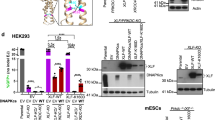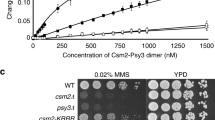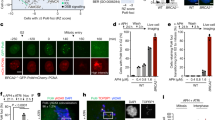Abstract
Microhomology-mediated end joining (MMEJ) is a Ku- and ligase IV–independent mechanism for the repair of DNA double-strand breaks that contributes to chromosome rearrangements. Here we used a chromosomal end-joining assay to determine the genetic requirements for MMEJ in Saccharomyces cerevisiae. We found that end resection influences the ability to expose microhomologies; however, it is not rate limiting for MMEJ in wild-type cells. The frequency of MMEJ increased by up to 350-fold in rfa1 hypomorphic mutants, suggesting that replication protein A (RPA) bound to the single-stranded DNA (ssDNA) overhangs formed by resection prevents spontaneous annealing between microhomologies. In vitro, the mutant RPA complexes were unable to fully extend ssDNA and were compromised in their ability to prevent spontaneous annealing. We propose that the helix-destabilizing activity of RPA channels ssDNA intermediates from mutagenic MMEJ to error-free homologous recombination, thus preserving genome integrity.
This is a preview of subscription content, access via your institution
Access options
Subscribe to this journal
Receive 12 print issues and online access
$189.00 per year
only $15.75 per issue
Buy this article
- Purchase on Springer Link
- Instant access to full article PDF
Prices may be subject to local taxes which are calculated during checkout





Similar content being viewed by others
References
Lieber, M.R. NHEJ and its backup pathways in chromosomal translocations. Nat. Struct. Mol. Biol. 17, 393–395 (2010).
McVey, M. & Lee, S.E. MMEJ repair of double-strand breaks (director's cut): deleted sequences and alternative endings. Trends Genet. 24, 529–538 (2008).
Boboila, C., Alt, F.W. & Schwer, B. Classical and alternative end-joining pathways for repair of lymphocyte-specific and general DNA double-strand breaks. Adv. Immunol. 116, 1–49 (2012).
Ma, J.L., Kim, E.M., Haber, J.E. & Lee, S.E. Yeast Mre11 and Rad1 proteins define a Ku-independent mechanism to repair double-strand breaks lacking overlapping end sequences. Mol. Cell. Biol. 23, 8820–8828 (2003).
Symington, L.S. Role of RAD52 epistasis group genes in homologous recombination and double-strand break repair. Microbiol. Mol. Biol. Rev. 66, 630–670 (2002).
Symington, L.S. & Gautier, J. Double-strand break end resection and repair pathway choice. Annu. Rev. Genet. 45, 247–271 (2011).
Mimitou, E.P. & Symington, L.S. Sae2, Exo1 and Sgs1 collaborate in DNA double-strand break processing. Nature 455, 770–774 (2008).
Shim, E.Y. et al. Saccharomyces cerevisiae Mre11/Rad50/Xrs2 and Ku proteins regulate association of Exo1 and Dna2 with DNA breaks. EMBO J. 29, 3370–3380 (2010).
Zhu, Z., Chung, W.H., Shim, E.Y., Lee, S.E. & Ira, G. Sgs1 helicase and two nucleases Dna2 and Exo1 resect DNA double-strand break ends. Cell 134, 981–994 (2008).
Mimitou, E.P. & Symington, L.S. DNA end resection: many nucleases make light work. DNA Repair (Amst.) 8, 983–995 (2009).
Buis, J. et al. Mre11 nuclease activity has essential roles in DNA repair and genomic stability distinct from ATM activation. Cell 135, 85–96 (2008).
Langerak, P., Mejia-Ramirez, E., Limbo, O. & Russell, P. Release of Ku and MRN from DNA ends by Mre11 nuclease activity and Ctp1 is required for homologous recombination repair of double-strand breaks. PLoS Genet. 7, e1002271 (2011).
Sartori, A.A. et al. Human CtIP promotes DNA end resection. Nature 450, 509–514 (2007).
Bennardo, N., Cheng, A., Huang, N. & Stark, J.M. Alternative-NHEJ is a mechanistically distinct pathway of mammalian chromosome break repair. PLoS Genet. 4, e1000110 (2008).
Lee-Theilen, M., Matthews, A.J., Kelly, D., Zheng, S. & Chaudhuri, J. CtIP promotes microhomology-mediated alternative end joining during class-switch recombination. Nat. Struct. Mol. Biol. 18, 75–79 (2011).
Truong, L.N. et al. Microhomology-mediated end joining and homologous recombination share the initial end resection step to repair DNA double-strand breaks in mammalian cells. Proc. Natl. Acad. Sci. USA 110, 7720–7725 (2013).
Zhang, Y. & Jasin, M. An essejntial role for CtIP in chromosomal translocation formation through an alternative end-joining pathway. Nat. Struct. Mol. Biol. 18, 80–84 (2011).
Dinkelmann, M. et al. Multiple functions of MRN in end-joining pathways during isotype class switching. Nat. Struct. Mol. Biol. 16, 808–813 (2009).
Lee, K. & Lee, S.E. Saccharomyces cerevisiae Sae2- and Tel1-dependent single-strand DNA formation at DNA break promotes microhomology-mediated end joining. Genetics 176, 2003–2014 (2007).
Xie, A., Kwok, A. & Scully, R. Role of mammalian Mre11 in classical and alternative nonhomologous end joining. Nat. Struct. Mol. Biol. 16, 814–818 (2009).
Rass, E. et al. Role of Mre11 in chromosomal nonhomologous end joining in mammalian cells. Nat. Struct. Mol. Biol. 16, 819–824 (2009).
Mortensen, U.H., Bendixen, C., Sunjevaric, I. & Rothstein, R. DNA strand annealing is promoted by the yeast Rad52 protein. Proc. Natl. Acad. Sci. USA 93, 10729–10734 (1996).
Sugawara, N. & Haber, J.E. Characterization of double-strand break–induced recombination: homology requirements and single-stranded DNA formation. Mol. Cell. Biol. 12, 563–575 (1992).
Villarreal, D.D. et al. Microhomology directs diverse DNA break repair pathways and chromosomal translocations. PLoS Genet. 8, e1003026 (2012).
Daley, J.M. & Wilson, T.E. Rejoining of DNA double-strand breaks as a function of overhang length. Mol. Cell. Biol. 25, 896–906 (2005).
Wold, M.S. Replication protein A: a heterotrimeric, single-stranded DNA-binding protein required for eukaryotic DNA metabolism. Annu. Rev. Biochem. 66, 61–92 (1997).
Sugiyama, T., New, J.H. & Kowalczykowski, S.C. DNA annealing by RAD52 protein is stimulated by specific interaction with the complex of replication protein A and single-stranded DNA. Proc. Natl. Acad. Sci. USA 95, 6049–6054 (1998).
Smith, J. & Rothstein, R. A mutation in the gene encoding the Saccharomyces cerevisiae single-stranded DNA–binding protein Rfa1 stimulates a RAD52-independent pathway for direct-repeat recombination. Mol. Cell. Biol. 15, 1632–1641 (1995).
Smith, J. & Rothstein, R. An allele of RFA1 suppresses RAD52-dependent double-strand break repair in Saccharomyces cerevisiae. Genetics 151, 447–458 (1999).
Soustelle, C., Vedel, M., Kolodner, R. & Nicolas, A. Replication protein A is required for meiotic recombination in Saccharomyces cerevisiae. Genetics 161, 535–547 (2002).
Umezu, K., Sugawara, N., Chen, C., Haber, J.E. & Kolodner, R.D. Genetic analysis of yeast RPA1 reveals its multiple functions in DNA metabolism. Genetics 148, 989–1005 (1998).
Chen, H., Lisby, M. & Symington, L. RPA coordinates DNA end resection and prevents formation of DNA hairpins. Mol. Cell 50, 589–600 (2013).
Milne, G.T., Jin, S., Shannon, K.B. & Weaver, D.T. Mutations in two Ku homologs define a DNA end-joining repair pathway in Saccharomyces cerevisiae. Mol. Cell. Biol. 16, 4189–4198 (1996).
Moore, J.K. & Haber, J.E. Cell cycle and genetic requirements of two pathways of nonhomologous end-joining repair of double-strand breaks in Saccharomyces cerevisiae. Mol. Cell. Biol. 16, 2164–2173 (1996).
Kantake, N., Sugiyama, T., Kolodner, R.D. & Kowalczykowski, S.C. The recombination-deficient mutant RPA (rfa1-t11) is displaced slowly from single-stranded DNA by Rad51 protein. J. Biol. Chem. 278, 23410–23417 (2003).
Lee, S.E. et al. Saccharomyces Ku70, mre11/rad50 and RPA proteins regulate adaptation to G2/M arrest after DNA damage. Cell 94, 399–409 (1998).
Lobachev, K.S., Gordenin, D.A. & Resnick, M.A. The Mre11 complex is required for repair of hairpin-capped double-strand breaks and prevention of chromosome rearrangements. Cell 108, 183–193 (2002).
Rattray, A.J., Shafer, B.K., Neelam, B. & Strathern, J.N. A mechanism of palindromic gene amplification in Saccharomyces cerevisiae. Genes Dev. 19, 1390–1399 (2005).
Gibb, B., Silverstein, T.D., Finkelstein, I.J. & Greene, E.C. Single-stranded DNA curtains for real-time single-molecule visualization of protein-nucleic acid interactions. Anal. Chem. 84, 7607–7612 (2012).
Gibb, B. et al. Concentration-dependent exchange of replication protein a on single-stranded DNA revealed by single-molecule imaging. PLoS ONE 9, e87922 (2014).
Graham, J.S., Johnson, R.C. & Marko, J.F. Concentration-dependent exchange accelerates turnover of proteins bound to double-stranded DNA. Nucleic Acids Res. 39, 2249–2259 (2011).
Liu, P., Carvalho, C.M., Hastings, P.J. & Lupski, J.R. Mechanisms for recurrent and complex human genomic rearrangements. Curr. Opin. Genet. Dev. 22, 211–220 (2012).
Stephens, P.J. et al. Complex landscapes of somatic rearrangement in human breast cancer genomes. Nature 462, 1005–1010 (2009).
Stephens, P.J. et al. Massive genomic rearrangement acquired in a single catastrophic event during cancer development. Cell 144, 27–40 (2011).
Pâques, F. & Haber, J.E. Multiple pathways of recombination induced by double-strand breaks in Saccharomyces cerevisiae. Microbiol. Mol. Biol. Rev. 63, 349–404 (1999).
Audebert, M., Salles, B. & Calsou, P. Involvement of poly(ADP-ribose) polymerase-1 and XRCC1/DNA ligase III in an alternative route for DNA double-strand breaks rejoining. J. Biol. Chem. 279, 55117–55126 (2004).
Mansour, W.Y., Rhein, T. & Dahm-Daphi, J. The alternative end-joining pathway for repair of DNA double-strand breaks requires PARP1 but is not dependent upon microhomologies. Nucleic Acids Res. 38, 6065–6077 (2010).
Wang, M. et al. PARP-1 and Ku compete for repair of DNA double strand breaks by distinct NHEJ pathways. Nucleic Acids Res. 34, 6170–6182 (2006).
Liang, L. et al. Human DNA ligases I and III, but not ligase IV, are required for microhomology-mediated end joining of DNA double-strand breaks. Nucleic Acids Res. 36, 3297–3310 (2008).
Simsek, D. et al. DNA ligase III promotes alternative nonhomologous end-joining during chromosomal translocation formation. PLoS Genet. 7, e1002080 (2011).
Wang, H. et al. DNA ligase III as a candidate component of backup pathways of nonhomologous end joining. Cancer Res. 65, 4020–4030 (2005).
Matsuzaki, K., Terasawa, M., Iwasaki, D., Higashide, M. & Shinohara, M. Cyclin-dependent kinase-dependent phosphorylation of Lif1 and Sae2 controls imprecise nonhomologous end joining accompanied by double-strand break resection. Genes Cells 17, 473–493 (2012).
Shibata, A. et al. Factors determining DNA double-strand break repair pathway choice in G2 phase. EMBO J. 30, 1079–1092 (2011).
Mimitou, E.P. & Symington, L.S. Ku prevents Exo1 and Sgs1-dependent resection of DNA ends in the absence of a functional MRX complex or Sae2. EMBO J. 29, 3358–3369 (2010).
Gravel, S., Chapman, J.R., Magill, C. & Jackson, S.P. DNA helicases Sgs1 and BLM promote DNA double-strand break resection. Genes Dev. 22, 2767–2772 (2008).
Chung, W.H., Zhu, Z., Papusha, A., Malkova, A. & Ira, G. Defective resection at DNA double-strand breaks leads to de novo telomere formation and enhances gene targeting. PLoS Genet. 6, e1000948 (2010).
Chen, C. & Kolodner, R.D. Gross chromosomal rearrangements in Saccharomyces cerevisiae replication and recombination defective mutants. Nat. Genet. 23, 81–85 (1999).
Chen, C., Umezu, K. & Kolodner, R.D. Chromosomal rearrangements occur in S. cerevisiae rfa1 mutator mutants due to mutagenic lesions processed by double-strand–break repair. Mol. Cell 2, 9–22 (1998).
Wang, Y. et al. Mutation in Rpa1 results in defective DNA double-strand break repair, chromosomal instability and cancer in mice. Nat. Genet. 37, 750–755 (2005).
Foster, S.S., Balestrini, A. & Petrini, J.H. Functional interplay of the Mre11 nuclease and Ku in the response to replication-associated DNA damage. Mol. Cell. Biol. 31, 4379–4389 (2011).
Langston, L.D. & Symington, L.S. Gene targeting in yeast is initiated by two independent strand invasions. Proc. Natl. Acad. Sci. USA 101, 15392–15397 (2004).
Decottignies, A. Microhomology-mediated end joining in fission yeast is repressed by pku70 and relies on genes involved in homologous recombination. Genetics 176, 1403–1415 (2007).
Davis, A.P. & Symington, L.S. The yeast recombinational repair protein Rad59 interacts with Rad52 and stimulates single-strand annealing. Genetics 159, 515–525 (2001).
Greene, E.C., Wind, S., Fazio, T., Gorman, J. & Visnapuu, M.L. DNA curtains for high-throughput single-molecule optical imaging. Methods Enzymol. 472, 293–315 (2010).
Acknowledgements
We thank R. Kolodner (Ludwig Institute for Cancer Research) and R. Rothstein (Columbia University) for the gifts of yeast strains and plasmids, C. Mott for strain construction and W.K. Holloman and members of the Symington lab for comments on the manuscript. This study was supported by grants from the US National Institutes of Health (R01 GM041784 (L.S.S.), R01 GM074739 (E.C.G.) and T32 CA009503 (S.K.D.)). This work was partially supported by the Nanoscale Science and Engineering Initiative of the US National Science Foundation under award CHE-0641523 to E.C.G. and by the New York State Office of Science, Technology and Academic Research (NYSTAR). E.C.G. is supported as an Early Career Scientist with the Howard Hughes Medical Institute.
Author information
Authors and Affiliations
Contributions
S.K.D., B.G., E.C.G. and L.S.S. designed experiments and wrote the paper. The experiments shown in Figures 1 and 2 and Supplementary Figures 1,2,3,4 were carried out by S.K.D., those shown in Figure 3 were carried out by S.K.D. and B.G., and those shown in Figure 4 were carried out by S.K.D. and M.J.d.A.
Corresponding author
Ethics declarations
Competing interests
The authors declare no competing financial interests.
Integrated supplementary information
Supplementary Figure 1 I-SceI cut site and repair sequences.
a, Sequence of Inverted I-SceI site and 12 bp microhomology b, I-SceI cut site with resulting overhangs c, Main classes of NHEJ events d, NHEJ events that yield an Ade+ phenotype. Deletion of any one of the five indicated nucleotides or GATA (4 consecutive nucleotides) restores the ADE2 reading frame to yield Ade+ NHEJ events e, MMEJ using 12 bp microhomology.
Supplementary Figure 2 MMEJ is Ku-independent and partially Sae2 dependent.
a, Linear substrate for blunt end joining (0 MH) or with a direct repeat (8-16 bp) to promote repair by MMEJ. b, Graph of end joining frequencies of the indicated strains; transformations were performed in triplicate and error bars show s.d. c, Graph showing the fraction of precise blunt end joining as determined by sequencing at least 16 independently derived Trp+ clones of the indicated genotypes. d, Graph showing the percent of circularization events that utilize the 12 bp MH as determined by sequencing 15-27 clones.
Supplementary Figure 3 The steady-state protein level of rfa1 mutants.
Western blot of extracts prepared from the indicated strains probed with anti-Rfa1 or anti-α tubulin antibodies (cropped version shown in Figure 2b).
Supplementary Figure 4 End resection and strand invasion in the rfa1 mutants.
a, Schematic representation of the band disappearance resection assay. Loss of the 0.7 and 2.6 kb away fragments indicate resection has proceeded beyond the Styl (S) and XbaI (X) restriction sites rendering them single-stranded and resistant to digestion. The red lines indicate the location of probes used to detect the 0.7 kb and 2.6 kb distal restriction fragments. b, Southern blot of StyI and XbaI digested genomic DNA isolated from wild type, rfa1-D228Y, rfa1-t33, and rfa1-t48 cells. c, Quantification of resection 0.7 kb and 2.6 kb away from the HO cut site. d, Schematic for the mating-type switching assay: the 0.9 kb StyI MATa fragment is cleaved upon HO induction to yield a 0.7 kb cut fragment. The 0.7 kb fragment disappears as resection proceeds and the break is repaired resulting in a 1.8 kb MATα fragment. e, Representative Southern blot of StyI-digested genomic DNA from wild type and rfa1-D228Y cells at different times after HO induction.
Supplementary information
Supplementary Text and Figures
Supplementary Figures 1–4, and Supplementary Tables 1 and 2 (PDF 1219 kb)
Rights and permissions
About this article
Cite this article
Deng, S., Gibb, B., de Almeida, M. et al. RPA antagonizes microhomology-mediated repair of DNA double-strand breaks. Nat Struct Mol Biol 21, 405–412 (2014). https://doi.org/10.1038/nsmb.2786
Received:
Accepted:
Published:
Issue Date:
DOI: https://doi.org/10.1038/nsmb.2786
This article is cited by
-
ssDNA accessibility of Rad51 is regulated by orchestrating multiple RPA dynamics
Nature Communications (2023)
-
Double-strand breaks induce inverted duplication chromosome rearrangements by a DNA polymerase δ-dependent mechanism
Nature Communications (2023)
-
Rtt105 regulates RPA function by configurationally stapling the flexible domains
Nature Communications (2022)
-
New insights into the mechanism of RPA in preserving genome stability
Genome Instability & Disease (2022)
-
POLθ-mediated end joining is restricted by RAD52 and BRCA2 until the onset of mitosis
Nature Cell Biology (2021)



